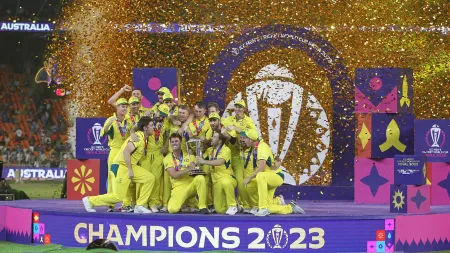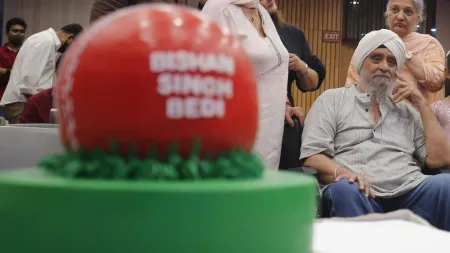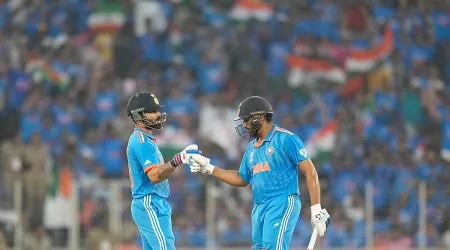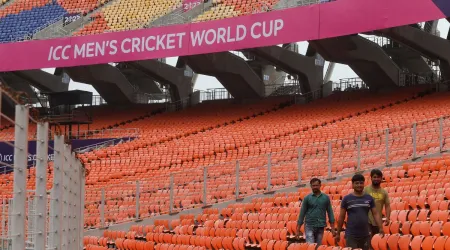- India
- International
After untimely snow, Ranji Trophy cricket in picturesque Srinagar after three years
After three years, cricket revisits a venue as breathtaking as Cape Town or Dharamsala, but more synonymous with political rallies
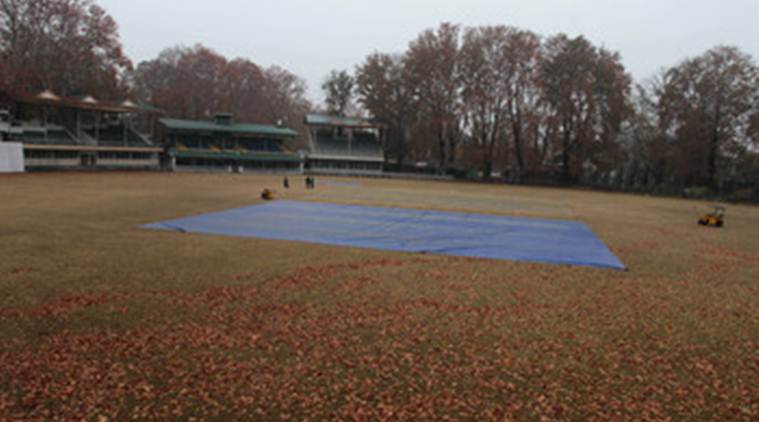 Three prime ministers – Atal Bihari Vajpayee, Manmohan Singh and Narendra Modi – have held rallies here. Shuaib Masoodi
Three prime ministers – Atal Bihari Vajpayee, Manmohan Singh and Narendra Modi – have held rallies here. Shuaib Masoodi
As Indian cricket embraces mofussil towns across the country, The Indian Express will bring to you, ahead of each Ranji Trophy round, the sights and sounds of these new frontiers.
Bang in the middle: A short walk from Lal Chowk, the city centre, takes you to the stadium. Roughly 100m from TRC Junction, watch out for a security check-post on the right. That’s the entry point to the stadium.
Picture perfect: The stadium offers a spectacular view from the pavilion and grandstand. You can see snow-covered hills in the background, the towering Chinar that envelope the entire stadium. Behind you, the Jhelum flows ever so gently.
Leafy Setting: Although just two stands, recently renovated, the stadium can accommodate 15,000. The rest are either completely covered by trees, or still under renovation.
The sound of an afternoon azaan is interrupted by a foot-tapping Bhojpuri song. Kashi Parswan stands on the edge of the boundary rope and gazes up at the symmetrical trees in front of him as he orders his team, armed with mops and brooms, to speed up their work.

On Tuesday, the picturesque ground in the heart of Srinagar will host its first Ranji Trophy match in three years when Jammu and Kashmir face Tripura. A fortnight ago, however, that looked a distant possibility. The stadium resembled an ice-skating rink, following untimely snowfall that covered the state’s summer capital in a sheet of white. But on the eve of the match, the venue bears a pristine look, as Parswan, the 47-year-old curator-cum-groundsman, has, in his own words, “sorted this out”.
Not ‘sorting this out’ was not an option for Parswan. Srinagar has waited long for big-time cricket. That it is being played at the iconic Sher-e-Kashmir Stadium – which has seen everything from protests to politics, natural calamities to some man-made ones – makes it even more special. “The stadium encapsulates everything that Kashmir is. There’s the hills, Chinar, Jhelum…” he says and adds with a smirk, “…and the Army.”
Best-kept secret
The Sher-e-Kashmir Stadium is one of Indian cricket’s best-kept secrets. And also a heavily guarded one. It’s a short walk from Lal Chowk, the city centre. Yet, it can be easily missed. The stands are hidden behind dense trees and there are no visible signboards that lead one to the ground. Instead, a security check-post roughly a hundred metres from the TRC junction is the first cue. The stadium periphery is dotted by offices and residences of the state’s top bureaucrats, making it one of the most guarded areas in the city.
On non-match days, it’s almost impossible to walk past the check point unless one has an authorisation. On the rare occasion when the stadium hosts a match, a special ID issued by the Jammu and Kashmir Cricket Association (JKCA) is the passport to cross those barricades. Once through, a narrow, winding lane leads one to the metal gates, next to which are a couple of signboards that read: “B Coy, 79 Battalion, Central Reserve Police Force.”
Or, in other words, the Sher-e-Kashmir Stadium. Once again, there’re no pointers suggesting that. From here, the stadium stands out only for one reason: the number of men trotting around in uniform. “This stadium has been providing shelter to the security forces for almost three decades now,” says a guard manning the entry gates. “Earlier, the dressing rooms and the stands doubled up as bunkers. A few years ago, we were moved to the back of the stadium.”
At every step, one is reminded of the volatile situation in the Valley, but walking those few extra yards had never seemed so rewarding, as the landscape undergoes unimaginable transformation the moment one steps on to the ground.
“Everyone raves about Dharamsala, par asli beauty yahan hai. Have you seen a backdrop more dramatic?” says Manzoor Wazir, a former Ranji player and office-bearer of the JKCA.
It’s tough to argue his point. Sher-e-Kashmir isn’t just one of the most scenic venues in the country, but potentially among the most breathtaking ones in the world, right up there with Cape Town, Queenstown and, of course, Dharamsala.
It is nestled at the bottom of the glorious Zabarwan ranges, which shimmer as the sun makes a rare, much-awaited appearance after two days of chilly, grey weather. Well below the towering hills are the mighty Chinar glowing in colourful hues. Behind the pavilion stand, the Jhelum flows ever so gently. “It’s serene here… a priceless piece of land.
Even the great Clive Lloyd, who played here in 1983, said he hadn’t seen a more beautiful venue,” Wazir says proudly, referring to the first international match played at this ground – between India and the West Indies. Wazir, a member of the organising committee of that match, recalls the day fondly. Most others, however, remember it differently.
Circa 1983
Much of Kashmir’s conflict, and history, can be traced through its stadiums. Sher-e-Kashmir is no different. If anything, it’s a little more controversial than the rest because of what transpired on that pleasant day in 1983, when Srinagar hosted its first international match. “Some locals weren’t happy with the decision to play an international match in J&K,” says 69-year-old Muhammad Yousuf, a cricket enthusiast who runs a tea stall nearby. “This was a disputed land and by playing an India match, some people felt they were trying to make a political statement.”
So when Kapil Dev led his world champion team out against the mighty West Indies in a re-match of the World Cup final, a section of the crowd welcomed them with catcalls and jeers. Sunil Gavaskar wrote in his book Runs ‘n’ Ruins, “… there were many in the crowd shouting pro-Pakistan slogans which confounded us, because we were playing the West Indies and not Pakistan.” During the innings break, a few from the crowd invaded the ground and dug up the pitch. The damage, however, wasn’t much and, cheered on by the crowd, the West Indies went on to win that rain-curtailed match. Sher-e-Kashmir has hosted just one more international match since then – in 1986, when Australia beat India.
Wazir downplays the 1983 incident. “There were a few rogue elements who tried to do something. But we had it under control. In fact, when Australia came a few years later, Kim Hughes said he could spend his entire career playing at this venue,” he says.
Alas, the stadium has barely been used for cricket since. There was no cricket played here between 1989 and 1996 because of the tense situation in the Valley. Even after that, the venue has seen more political battles than cricketing ones. Three prime ministers—Atal Bihari Vajpayee, Manmohan Singh and Narendra Modi—have held rallies here, apart from several state-level political events. In 2009, when the Services team refused to play a Ranji match in Srinagar due to security concerns, the then JKCA president and union minister Farooq Abdullah blamed it on “vested interests” out to give Kashmir “a bad name”.
The last time a cricket match was played here was in 2015, when J&K and Kerala played out a high-scoring draw. “Kya kuchh nahi dekha is stadium ne,” Parswan says. “Ab thoda cricket bhi dekh lenge yahan.”
Parswan says this will be the first time the newly-laid pitch with be used. Truck-loads of black soil was transported from Haryana but at the moment, there’s little to separate the outfield from the square. “We got black soil from Haryana and relaid the pitches. I think this will suit the batsmen, unless it’s cold and overcast. In that case, it’ll be a nightmare for them,” he says mischievously.
There’s a vested interest, however, in doing so. “If you are batting at the Pavilion End, the ball frequently gets lost in the trees since the boundaries are short. We need 4-5 kids just to recover them,” Parswan says.
When the clock strikes 9 on Tuesday morning, though, this will be the least of his worries. They’re just happy that the stadium is hosting what it’s supposed to – a cricket match.
Get latest updates on IPL 2024 from IPL Points Table to Teams, Schedule, Most Runs and Most Wickets along with live score updates for all matches. Also get Sports news and more cricket updates.



















